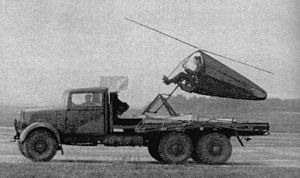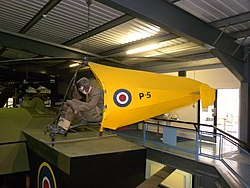225:
200:. On 29 May 1942, the first flight of the Rotachute Mark II was achieved while under tow behind a Jeep, and several more towed flights were also successful. Meanwhile, the Mark III had been produced, with a tail section comprising a wooden framework covered in doped linen fabric plus a rigid tailplane. Starting on 2 June 1942, the Rotachute Mark III was flown at heights up to 100 ft (30.5 m) while under tow behind a Jeep, with tow rope lengths up to 300 ft (91.4 m). From 9 June, successful inflight releases and landings were achieved while under tow.
141:. In October 1940, work began on design and construction of rotor systems and scale models of rotor kites. The first models were made of wood and fabric, ballasted to represent a pilot, and had a rotor span of about 3 ft (0.91 m). They were tested successfully by hand launching, but suffered buffeting and lack of autorotation when launched from aircraft at height. The third evolution, designated "M.3", had metal rotor blades, and after further modifications made the first successful launch and descent from a
39:
158:
framework with a single seat, rubber-mounted rotor hub, hanging control column, skid undercarriage, and a self-inflating rear fairing made of rubberised fabric with integral tailplane. The two rotor blades, of wooden construction, could achieve flapping and coning characteristics via hinges on the rotor hub. Fixed footrests were provided, plus fittings below the seat to accommodate a soldier's weapon, such as a
188:
and a longer test flight at RAF Snaith were both more successful. The flexible tail section evidently offered inadequate directional stability, and the consequence was the
Rotachute Mark II, that had a longer tail section braced with wooden formers, plus two landing wheels mounted below the centre of
157:
The design of the man-carrying machine known as a
Rotachute, also known as a Hafner H.8, evolved from November 1940 and throughout 1941. In September 1941, the Central Landing Establishment was renamed the Airborne Forces Establishment. The Rotachute Mark I design initially comprised a tubular steel
175:
In
January 1942, trials of the Rotachute Mark I were conducted to assess the aerodynamic characteristics while on the truck-mounted rig, with pilot control of the aircraft in forward motion. On 11 February 1942, the prototype Rotachute was first manually flown from a wheeled trolley while under tow
132:
The
Rotachute was the eventual development of a concept devised by Raoul Hafner, an Austrian engineer who specialised in rotary wing design, and who had moved to the UK in 1933 to continue his research and development work. In 1940, he proposed the use of a single-place strap-on rotor kite in place
211:
Although the
Rotachute concept had proved to be practical, the operational requirement for such a machine never materialised. About eight Rotachutes were constructed, most being progressively converted to Mark III and then to Mark IV specifications. They continued to be flown in ground-based and
203:
From 17 June 1942, a
Rotachute Mark III was air-towed behind a Tiger Moth on a 300 ft (91.4 m) tow line. After two towed flights, the Rotachute was released at an altitude of 200 ft (61 m) and made the first manned free flight and controlled landing. Further free flights were made from
166:
No. 11/42 was issued retrospectively to describe the outline requirements. The
Ministry of Aircraft Production sub-contracted construction of parts to specialist firms including F. Hills and Sons, Airwork General Trading, Dynaflex, Dunlop, and H. Morris & Co. Some full size rotor trials were
133:
of a conventional parachute, to deliver a soldier accurately to a battlefield. The proposal was made to the Air
Ministry in the light of a shortage of silk for parachute manufacture. Hafner was briefly interned as an alien, but was released to pursue the feasibility of the idea at the
145:. Further developments and tests continued into February 1941. The tenth evolution scale model (M.10) had mass-balanced wooden rotors, ballast of 100 lb (45.3 kg), and a rotor span of 10 ft (3.05 m). On 14 March 1941, the M.10 model was successfully air-launched from a
184:. On that and on a subsequent trial, the machine rolled over after landing, sustaining damage to the blades but not to the pilot. A tethered test beneath a
196:(AFEE), still based at Ringway. The rotary wing section of AFEE continued to conduct tests on longer runways during detachments at RAF Snaith and
167:
carried out using a pivoting rig mounted on a Ford flatbed truck, and full-size unmanned airframes were used in ground-based and inflight trials.
546:
526:
582:
521:
193:
500:
473:
208:. Additional directional stability was achieved in the Rotachute Mark IV, that introduced endplates onto the rigid tailplanes.
176:
behind a Humber car at
Ringway, after starting the rotor by hand. The pilot was Flt Lt I.M. Little, who had experience flying
587:
231:
The fifth aircraft (P-5) was a
Rotachute Mark III, converted in 1943 to the Mark IV configuration, and is displayed at the
163:
162:. The control column offered two-axis control, rolling and pitching, with turns made via controlled rolling movement.
181:
454:
493:
134:
146:
212:
inflight trials until late 1943, to help research flight characteristics for a follow-on project, the
17:
224:
541:
536:
531:
486:
417:
204:
altitudes up to 3,900 ft (1,189 m). On 1 July 1942, AFEE moved its main base from Ringway to
142:
329:
232:
205:
577:
392:
8:
450:
556:
213:
185:
197:
571:
236:
509:
121:
78:
390:
177:
138:
478:
117:
55:
159:
38:
240:
192:
On 15 February 1942, the unit was again reorganised, to form the
180:
autogiros on radar calibration duties; he was later awarded the
216:, an air-towed land vehicle with autogiro capabilities.
391:
Serge Van Heertum; Philippe Decock; Marc Arys (2015).
246:
459:Jarrett, Philip. "Nothing Ventured ... Part 17".
569:
46:Ground test of a Rotachute III at Ringway, 1942
494:
501:
487:
319:108 mph (173.8 km/h, 94 kn)
194:Airborne Forces Experimental Establishment
508:
377:
375:
373:
371:
369:
367:
365:
355:
353:
351:
349:
347:
345:
152:
116:was a British 1940s experimental one-man
223:
14:
570:
362:
342:
170:
482:
583:1940s British experimental aircraft
24:
474:Rotachute at Museum of Army Flying
393:"Middle Wallop Army Flying Museum"
304:177 sq ft (16.44 m)
298:15 ft 0 in (4.57 m)
274:10 ft 0 in (3.05 m)
25:
599:
467:
397:Sierra Bravo Aero Pictures (SBAP)
280:5 ft 0 in (1.52 m)
247:Specifications (Rotachute Mk III)
37:
463:, August 1991, pp. 470–476
439:
410:
384:
13:
1:
147:Boulton & Paul Overstrand
135:Central Landing Establishment
127:
588:Aircraft first flown in 1942
219:
7:
323:
292:295 lb (133.8 kg)
10:
604:
447:British Prototype Aircraft
164:Air Ministry Specification
517:
286:76 lb (34.5 kg)
45:
36:
31:
335:
445:Sturtivant, Ray. 1995.
418:"Museum of Army Flying"
259:General characteristics
143:De Havilland Tiger Moth
359:Sturtivant 2007, p. 38
228:
153:Design and development
330:Focke-Achgelis Fa 330
233:Museum of Army Flying
227:
206:RAF Sherburn-in-Elmet
178:Avro/Cierva C.30 Rota
296:Main rotor diameter:
182:Air Force Cross (UK)
114:Hafner H.8 Rotachute
171:Operational history
229:
565:
564:
461:Aeroplane Monthly
422:aviationmuseum.eu
137:(CLE) located at
110:
109:
32:Hafner Rotachute
16:(Redirected from
595:
503:
496:
489:
480:
479:
433:
432:
430:
428:
414:
408:
407:
405:
403:
388:
382:
379:
360:
357:
312:
302:Main rotor area:
261:
214:Hafner Rotabuggy
103:
67:
59:Type of aircraft
41:
29:
28:
21:
603:
602:
598:
597:
596:
594:
593:
592:
568:
567:
566:
561:
513:
507:
470:
442:
437:
436:
426:
424:
416:
415:
411:
401:
399:
389:
385:
380:
363:
358:
343:
338:
326:
308:
257:
249:
222:
186:barrage balloon
173:
155:
130:
101:
66:National origin
65:
60:
23:
22:
15:
12:
11:
5:
601:
591:
590:
585:
580:
563:
562:
560:
559:
554:
549:
544:
539:
534:
529:
524:
518:
515:
514:
506:
505:
498:
491:
483:
477:
476:
469:
468:External links
466:
465:
464:
457:
441:
438:
435:
434:
409:
383:
361:
340:
339:
337:
334:
333:
332:
325:
322:
321:
320:
317:Maximum speed:
306:
305:
299:
293:
287:
281:
275:
269:
248:
245:
221:
218:
198:RAF Chelveston
172:
169:
154:
151:
129:
126:
108:
107:
104:
98:
97:
94:
90:
89:
86:
82:
81:
76:
72:
71:
68:
62:
61:
58:
52:
48:
47:
43:
42:
34:
33:
9:
6:
4:
3:
2:
600:
589:
586:
584:
581:
579:
576:
575:
573:
558:
555:
553:
550:
548:
545:
543:
540:
538:
535:
533:
530:
528:
525:
523:
520:
519:
516:
511:
504:
499:
497:
492:
490:
485:
484:
481:
475:
472:
471:
462:
458:
456:
452:
448:
444:
443:
423:
419:
413:
398:
394:
387:
378:
376:
374:
372:
370:
368:
366:
356:
354:
352:
350:
348:
346:
341:
331:
328:
327:
318:
315:
314:
313:
311:
303:
300:
297:
294:
291:
290:Gross weight:
288:
285:
284:Empty weight:
282:
279:
276:
273:
270:
267:
264:
263:
262:
260:
255:
253:
244:
242:
238:
237:Middle Wallop
234:
226:
217:
215:
209:
207:
201:
199:
195:
190:
187:
183:
179:
168:
165:
161:
150:
148:
144:
140:
136:
125:
123:
119:
115:
105:
100:
99:
95:
92:
91:
87:
85:First flight
84:
83:
80:
77:
74:
73:
69:
64:
63:
57:
53:
50:
49:
44:
40:
35:
30:
27:
19:
551:
510:Raoul Hafner
460:
446:
440:Bibliography
425:. Retrieved
421:
412:
400:. Retrieved
396:
386:
381:Jarrett 1991
316:
309:
307:
301:
295:
289:
283:
277:
271:
265:
258:
256:
254:Jarrett 1991
251:
250:
230:
210:
202:
191:
174:
156:
131:
122:Raoul Hafner
120:designed by
113:
111:
102:Number built
79:Raoul Hafner
26:
578:Rotor kites
310:Performance
139:RAF Ringway
572:Categories
455:1856482219
128:Background
118:rotor kite
56:rotor kite
557:Rotabuggy
552:Rotachute
449:. Haynes
252:Data from
220:Survivors
189:gravity.
93:Produced
75:Designer
18:Rotachute
512:aircraft
324:See also
160:Bren gun
532:A.R.III
427:1 March
402:1 March
278:Height:
272:Length:
241:England
54:manned
537:A.R.IV
453:
542:A.R.V
336:Notes
266:Crew:
239:, in
106:c. 8
96:1942
88:1942
51:Role
547:PD.6
527:R.II
451:ISBN
429:2019
404:2019
112:The
522:R.I
70:UK
574::
420:.
395:.
364:^
344:^
243:.
235:,
149:.
124:.
502:e
495:t
488:v
431:.
406:.
268:1
20:)
Text is available under the Creative Commons Attribution-ShareAlike License. Additional terms may apply.

